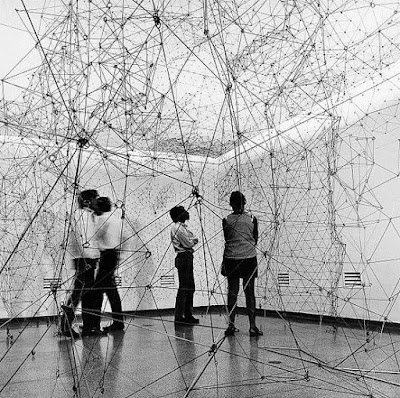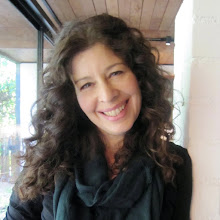Vija Celmins Web #2 2000-2001 Oil on linen
We caught the last day of Vija Celmins' retrospective at SFMOMA recently. Her spiderweb depictions started me thinking about their structures and the wide range of structures based on them. Also about webs and nets and how they have a fluidity of form that allows for distortion that can encompass so much variety. Net patterns are also simply beautiful on their own and as they become a frame for what's enclosed in an open way.
The title of this post comes from a line in a book I'm reading....The Last Romantics, by Tara Conklin. It seemed to be just what I was thinking about...knotted, woven, linked.
Vija Celmins Web #3 2000-2002 Oil on linen
Above: Garth William's original drawing from Charlotte's Web by E. B. White, used for the book's end papers.
Above: Senga Nengudi, from her performance piece Improvisational Gestures, part of a larger exhibit at the USC Fisher Museum of Art. More of her work can be seen here.
Above and below: Louise Bourgeois. More images of her spider themed work in Louise Bourgeois: The Spider and the Tapestries, 2015.
Above: Wallpaper design, 1880s, by Candace Wheeler (1827-1923). This was part of a show at the Met "The Art of the Spider's Web" in 2017.
Above: Chanel runway detail, September 2011.
Above: Fishnet shaped tile detail.
Above: A vintage photo of the lounge at the "Parco Dei Principi Hotel", Sorrento, Italy, designed by Gio Ponti in 1961.
Above: Setting The Bow Net, Peter Henry Emerson, England, 1886, platinum print.
Above: Martin Puryear, Untitled I 2002, Aquatint.
Above: Bronwyn Joy Oliver (1959-2006), Apostrophe, 1987, copper and lead.
Above: Alan Saret, ING, 1983, wire
Above: Since 1622 Larrieu Freres has been making nets in Bordeaux, France for all sorts of purposes...fishing, sports, birding, agriculture, and so on. The descendants of the founder, Baptiste Guignan, have run the business for close to 400 years.
Above: Gerald Dillon (1916-1971), Mending Nets, Aran
Above: Christopher Wood (1901-1930), Mending nets, Treboul, 1930, pencil and gouache.
Photo: Ferdinand Boesch
Above: Lenore Tawney, (1907-2007) working on Vespers, South Street Studio, 1961.
Above and below: Rana Begum assembling a site specific sculpture at St. Peter's Church at Kettle's Yard, Cambridge. She is joining a thousand bamboo baskets hand woven in Bangladesh to create the piece, part of a group show called "Actions. The image of the world can be different."
Photo: link here
Above: Tara Donovan, Detail of Untitled Ballpoint Pen Drawing, 2002.
Above: Jacket made with fabric from the Ivory Coast
Above: Roe Etheridge, Cliff in Montauk with Net, 2008, C-print.
Above: Sheila Pepe's "Your Granny's Not Square", 2008, detail. Crocheted shoelaces and yarn.
Photo: Joshua White
Above: Liza Lou, Pyrocumulus, 2018, detail. From Liza Lou's show at Lehmann Maupin "Classification and Nomenclature of Clouds".
Photo: Laura Clayton Baker
Above: Uplifters Tea Cup, ash and feldspar glaze, 2019.
Photo: Cheryl Rose
Above: Dragonfly Wings, May 2013
Above: John William Godward, Mischief and Repose, 1895. (detail).
Above: Brice Marden "The Studio", 1990
Above: Dan Miller, Untitled (fine silver line on blue), 2014. Dan Miller is one of the artists working at Creative Growth.
Above and below: Toshiko Horiuchi has created "Woods of Net", a hand crocheted environment for kids to crawl in and jump on and explore at the Hakone Open Air Museum. This came to life on yarn bombing day, 2012.
Above: Liza Lou, "Perfect Day", 2016.
Above: Spiderman's wrist mounted web shooter.
Above: Tomas Saraceno "In Orbit", 2013, permanent installation at Kunstsammlun, Dusseldorf. Visitors are invited in to this clear steel mesh structure suspended 82 feet over the piazza at the base. As they move through it the tension of the cables alters, vibrates, and changes form. Influenced by spider webs as well as utopian architects like Buckminster Fuller it envisions a floating city of the future.
Above: Tomas Sarceno "On Air", exhibit at the Palais de Tokyo, Paris. This is a more grounded installation than the previous one.
Photo: Paolo Gasparini
Above: Gego (Gertrud Goldschmidt), "Reticularea", 1972. Exhibition view from Museo de Bellas Artes, Caracas. You can see the influence of Gego's ideas on Sarceno's installations 40 years later.
Above: Gego working on an installation.
Above: Faith Wilding "Crocheted Environment", 1972. This piece was installed at the ICA in Boston in 1995. also known as the Womb Room, it was part of the 1972 exhibition Womanhouse organized by Judy Chicago and Miriam Schapiro, co-founders of the California Institute of the Arts Feminist Art Program.
Above and below: Ernesto Neto's Installation "The Serpent's Energy Gave Birth to Humanity", 2016, Tanya Bonakdar Gallery.
Above: Ernesto Neto installation "O Sagrado e Amor" (the Sacred is Love) at "Fortes D'Aloia & Gabriel", 2017
Above: Poncho patterns for knitting.
Above: Ernesto Neto, "Kink", 2012, Nasher Sculpture Center.
Above: Ernesto Neto installation at Fortes D'Aloia & Gabriel, 2012.
Above: Book on Ikebana by legendary Sofu Teshigahara, the founder of the Sogetsu-ryu school of flower arranging.
Above: Ruth Asawa wire sculptures
Above: Ruth Asawa immersed in one of her pieces.
Above: Ruth Asawa, sculpture detail
Above: Detail of linked piece by El Anatsui, Jack Shainman gallery.
Above: Detail of crocheted ribbon from a piece by Jim Drain at the Parker Gallery, Los Feliz.
Above: Vessel by Kazunori Hamana, "Tsubo 28"
Above: Yarn detail
Above: Yayoi Kusama, Red Nets, 1966
Above: Ad for Vitality shoes, Cosmopolitan Magazine, April 1968
Above: 70's British punk rockers wearing fishnet stockings, London Underground.
Photo: Bassano Ltd.
Above: Audrey Hepburn in costume for "The Secret People", November 21 1950. Collection National Portrait Gallery UK.
Above: Pattern for knitting stockings.
Above: Crochet instructions
Above: Kimono fragment with net pattern and plovers, Japan, late Edo period (1615-1868), collection LACMA.
Photo: Laura Clayton Baker
Above: Diamond mesh security grill, Jefferson Blvd., Los Angeles
Above and below: Vintage outdoor composite chair, 1960s.
Above: Net bag
Above: Claire Falkenstein (1908-1997), Untitled, 1956, burnt bamboo root and steel wire.
Above: Lucie Rie (1902-1995)
Above: Ruth Asawa, sculpture detail
Above: Eva Hesse (1936-1970), Untitled (Three nets), 1966
Above: Eva Hesse (1930-1970)
Photo: Joshua White
Above and below: Liza Lou "Lacunosis", 2018.
Photo: Joshua White
Above: Alexandra Bircken "Warmegitter", 2011
Above: Vintage photo of fishing net
Above: Hawaiian net fishing, Bishop Museum archive.
Above: Callum Livingstone mending fishing nets in Aird, late 1960s.
Above and below: Pages from a favorite book of mine when I was in my teens..."Living on The Earth" by Alicia Bay Laurel. Making a hammock instructions above, making a market bag below.
Above: Fishnet for window covering.
Above: Knotted chair by Marcel Wanders, 1995
Above: Toshiko Horiuchi Fibre Columns/Romanesque Church, nylon rope, 1976.
Above: Vaulting of Cathedral of St. Peter, Bautzen, Germany. Constructed in the mid 15th century, it was reconstructed after a fire in 1634.
Photo: A. Osio
Above: Mona Hatoum, Conversation Piece, 2009. Shown at Galleria Continua, San Gimignano, Italy. Seen on a blog by Joanne Mattera about webs used in art.
Photo: David Stephenson, 2006
Above: Intricate webbing above the choir of Gloucester Cathedral, Gloucester, England. From a book by David Stephenson, "Heavenly Vaults: From Romanesque to Gothic in European Architecture", 2009.
Above: Nave, Church of Santa Maria, Hieronymite Monastery, Belem, Portugal, 1501-1601.
Above: Louis Kahn, National Parliament of Bangladesh. Conceived in 1959, it wasn't built until after Bangladesh had declared independence from Pakistan, and it was completed in 1982.
Photo: Marianne Cotterill
Above: Dining table, Charleston, the home of Vanessa Bell and Duncan Grant, and other members of the Bloomsbury group. Vanessa Bell painted the surface of the dining table in 1952.
Photo: Ute Kluge
Above: Lanterns
Above: Warren Platner Lounge Chair, 1966, manufactured by Knoll. Shown here without cushions. Found here.
Above: A view of Antonio Gaudi's hanging model for the Colonia Guell. Gaudi would hang strings and chains upside down to develop his forms. He weighted the strings with birdshot. When inverted the forms would stand in pure compression. More here.
Above: R. Buckminster Fuller and students pose with his first model Geodesic Dome.
Above: R. Buckminster Fuller holding a Tensegrity sphere, 1979.
Above: Ross Bleckner, Botanical Study, 1993, 60" x 60".
Above: Wilson Bentley (1865-1931), Dew on a Spider's Web, 1910.
Above: David Hammons, Basketball Chandelier, 1997
Above: Found this chair photo here.
Above: Motoi Yamamoto creating a salt installation at the Halsey Institute of Contemporary Art. Working with salt, a symbol of mourning, has been a way to work through his grief over losing his sister to cancer at 24 years old. Making these labyrinthine pieces is a meditative process for him.
Photo: Clay Perry
Above: Mira Schendel (1919-1988) and Little Nothing, London, 1966
Above: Atsuko Tanaka (1932-2005), Untitled, 1961. Tanaka was an early part of the Gutai group in Japan, a radical group of Osaka based artists founded in 1954. She was best known for her electric dress.
Above: Atsuko Tanaka
Above: Atsuko Tanaka, From the drawings for Electric dress series, 1957.
Above: Net bag from Christopher Kane runway fall/winter 2016/2017.
Above: Jaro Fabry, Woman with a butterfly in her hat, Collier's cover illustration, 1938
Above: Roe Ethridge, this was done as part of a campaign for Sportmax.
Above: Net making, Vietnam
Above: Emma Davies, Vessels, 2015
Above: B. Wurtz, Untitled, Wood, wire, mesh netting
Above: Patricia Urquiola Re-Trouve line of garden furniture designs.
Above: Alvin Lustig's dust jacket for Henry James' "The Spoils of Poynton", 1947.
Above: The "Bilange" Body Sponge, 1989. Part of an exhibition at MOMA, Mutant materials in contemporary design, 1995. Designed by William Hudson, Angela Kortelink, and Siamak Samli. A soft airy sponge made of nonporous polyethylene netting handmade into a puff form with no absorption characteristics.
Above: Judith Scott (1943-2005), Untitled, 2004, from her retrospective at the Brooklyn Museum. Scott, born with down syndrome, and deaf, was institutionalized most of her life. When her twin sister became her legal guardian she brought Judith to Creative Growth in Oakland, an art workshop space for developmentally disabled adults. Scott thrived there, where she found her medium, wrapping found objects in yarn and strips of fabric.
Above: Sheila Hicks, Grand Boules, 2009
Above and below: Paola Anziche, 2016, at Laboratorio Del Dubbio.
Above: Artist unknown
Above: Terry Winters, from his artist's book "Filters in Stock", 2009, 38th St. Publishers
Above: Kanayama Akira (1924-2006) Part of the Gutai group, he addressed the process of making a painting using mechanical methods.
Above: Dan Miller, an artist working at Creative Growth.
Above: Sol Lewitt "Wall Drawing #51", June 1970.
Photo: John D. Schiff
Above: Installation view of "First Papers of Surrealism" exhibit showing Marcel Duchamp's "His Twine", 1942.
Above: A window guard becomes an opportunity to make something interesting.
Above: Leon Ferrari (1920-2013), from his show "For a World with no Hell" at the Galeria Nara Roesler Sao Paulo.
Above: Harry Kramer, Torso, 1962, wire construction with electric motor.
Above: Brice Marden Cold Mountain 6 (Bridge), 1989-1991, collection SFMOMA
Above and below: My husband Steven's collages made of painted and cut paper, details.
Above: Lee Bontecou, Untitled, 1960, welded steel, canvas, and wire.
Above: Dora Maar (1907-1997), Les Annees Vous Guettent, 1936.
Below: Louise Bourgeois "Untitled" (double sided), 2006






































































































































